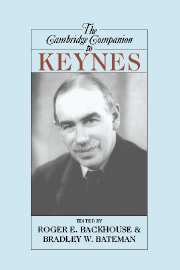Book contents
- Frontmatter
- 1 A cunning purchase: the life and work of Maynard Keynes
- 2 The Keynesian revolution
- 3 Keynes and the birth of modern macroeconomics
- 4 Keynes as a Marshallian
- 5 Doctor Keynes: economic theory in a diagnostic science
- 6 Keynes and British economic policy
- 7 Keynes and Cambridge
- 8 Keynes and his correspondence
- 9 Keynes and philosophers
- 10 Keynes’s political philosophy
- 11 Keynes and probability
- 12 The art of an ethical life: Keynes and Bloomsbury
- 13 Keynes and ethics
- 14 Keynes between modernism and post-modernism
- 15 Keynes and Keynesianism
- Bibliography
- Index
8 - Keynes and his correspondence
Published online by Cambridge University Press: 28 November 2006
- Frontmatter
- 1 A cunning purchase: the life and work of Maynard Keynes
- 2 The Keynesian revolution
- 3 Keynes and the birth of modern macroeconomics
- 4 Keynes as a Marshallian
- 5 Doctor Keynes: economic theory in a diagnostic science
- 6 Keynes and British economic policy
- 7 Keynes and Cambridge
- 8 Keynes and his correspondence
- 9 Keynes and philosophers
- 10 Keynes’s political philosophy
- 11 Keynes and probability
- 12 The art of an ethical life: Keynes and Bloomsbury
- 13 Keynes and ethics
- 14 Keynes between modernism and post-modernism
- 15 Keynes and Keynesianism
- Bibliography
- Index
Summary
INTRODUCTION
By almost any standard, Maynard Keynes was a massive correspondent. The Collected Writings contain full transcriptions or excerpts from over 2,000 unpublished letters and 202 published letters to newspapers. Added to those are 413 minutes and 364 memoranda or comments. The Collected Writings are far from complete. Maria Cristina Marcuzzo in this volume (chapter 7) notes that there are 2,140 published and unpublished letters to Gerald Shove, Dennis Robertson, Richard Kahn and Joan Robinson, as well as a further 370 to A. C. Pigou and Piero Sraffa. One could add the long non-professional runs of letters, most notably to his parents, Lytton Strachey, Duncan Grant, Vanessa Bell and Lydia Lopokova.
The mass of this surviving correspondence owes much to the fact that Keynes rarely threw anything away. From an early stage in his professional career he had a secretary whose carbon copies remained in his papers. He also spent almost twelve years in the Treasury, which, despite the disruptions of its being blitzed in 1940, was remarkably efficient at keeping paper, even if significant amounts of 1914-19 material ended up in Keynes's own papers. Even out of the Treasury he generated correspondence and reactions from Treasury officials. Finally, some of the recipients of his letters were themselves pack rats.
- Type
- Chapter
- Information
- The Cambridge Companion to Keynes , pp. 136 - 159Publisher: Cambridge University PressPrint publication year: 2006
- 4
- Cited by

